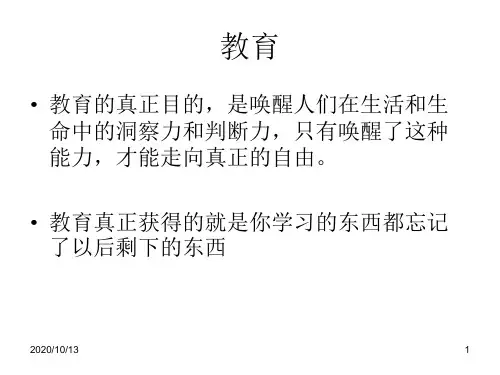间接言语行为理论.ppt
- 格式:ppt
- 大小:1.55 MB
- 文档页数:23
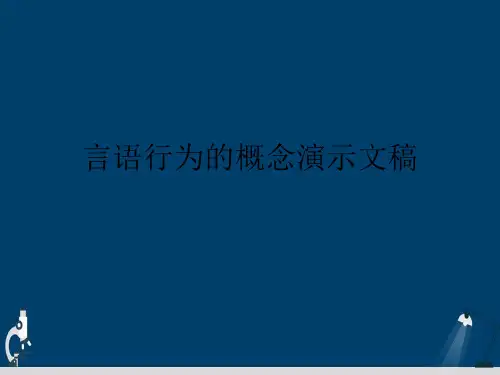

言语行为理论言语行为的应用语言作为一种行为存在于我们的日常交际中,被人们广泛的使用,对言语行为的关注有助于提高我们语言使用的语用意识。
在此,我对“请求”、“拒绝”和“撒谎”的言语行为进行一个讨论。
2.1“请求”言语行为“请求”是一种使役性的言语行为,它的使用涉及到面子的威胁也就是礼貌及其程度问题。
因此,人们在运用表示请求的言语时为了顾全面子,通常都不会直截了当的发出请求,而是借助一定的辅助性话语和间接性话语,以降低请求所产生的使役性,或减少该行为所带来的负面效应。
例如:(1) 嗨,小张,我的自行车坏了,可不可以借用一下你的?我明天一定还你。
例(1)是一个请求借用自行车的言语行为,在我们日常生活中此类的话语随处可见。
例(1)这一长串话语所表达的中心就是“借一下你的自行车”这一中心行为,其他部分都是服务于该中心的附加性话语,其中“嗨,小张”是一种称呼语,用于打招呼,表示友好,引起对方注意;“我的自行车坏了”是一个信息的陈述,是提供请求原因的辅助性话语,为之后所实施的请求的言语行为创造条件;“可不可以…?”是人们实施请求行为时采用的委婉形式,有助于降低请求产生的驱使性;“我明天一定还你”则是实施请求的后置辅助性话语,它可以推动促成该行为的顺利实施。
由此可见,言语行为在具体运用于请求时,根据语境添加大量的附加性话语请求功能的顺利完成。
2.2“拒绝”言语行为“拒绝”言语行为是针对对方的请求、邀请或建议之后,说话人做出的一种“不合作性”选择,有时候也就是我们汉语所指的“婉言谢绝”、“断然拒绝”、“一口回绝”等说法,拒绝言语行为广泛存在于言语交际,而且形式多种多样。
例如,(2)女儿:妈妈,我去逛街了母亲:不可以,写作业!(3)小王:小明,你把橡皮擦借我用下吧小明:上次你都不借我(4)甲:明天下午去打球吧!乙:我明天有课(5)甲:请问考试是在什么时间啊?乙:你上网查查就知道了(6)售货员:就买这件吧,挺合适的顾客:贵了点,看看别的吧从以上的例子可以看出,“拒绝”言语行为在具体应用时是各种各样的:例(2)是直接拒绝,(3)是批评性的婉拒;(4)是提供原因或借口的婉拒;(5)是提供建议的婉拒;(6)则是提供借口,再建议,表示婉拒。
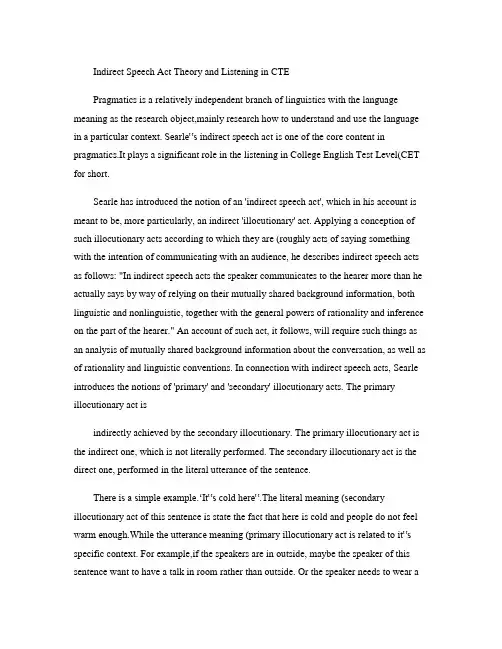
Indirect Speech Act Theory and Listening in CTEPragmatics is a relatively independent branch of linguistics with the language meaning as the research object,mainly research how to understand and use the language in a particular context. Searle‟s indirect speech act is one of the core content in pragmatics.It plays a significant role in the listening in College English Test Level(CET for short.Searle has introduced the notion of an 'indirect speech act', which in his account is meant to be, more particularly, an indirect 'illocutionary' act. Applying a conception of such illocutionary acts according to which they are (roughly acts of saying something with the intention of communicating with an audience, he describes indirect speech acts as follows: "In indirect speech acts the speaker communicates to the hearer more than he actually says by way of relying on their mutually shared background information, both linguistic and nonlinguistic, together with the general powers of rationality and inference on the part of the hearer." An account of such act, it follows, will require such things as an analysis of mutually shared background information about the conversation, as well as of rationality and linguistic conventions. In connection with indirect speech acts, Searle introduces the notions of 'primary' and 'secondary' illocutionary acts. The primary illocutionary act isindirectly achieved by the secondary illocutionary. The primary illocutionary act is the indirect one, which is not literally performed. The secondary illocutionary act is the direct one, performed in the literal utterance of the sentence.There is a simple example.‘It‟s cold here‟.The literal meaning (secondary illocutionary act of this sentence is state the fact that here is cold and people do not feel warm enough.While the utterance meaning (primary illocutionary act is related to it‟s specific context. For example,if the speakers are in outside, maybe the speaker of this sentence want to have a talk in room rather than outside. Or the speaker needs to wear amore coat or the speaker caught a cold. If the speakers are in the room, the utterance meaning of the sentence maybe to have others closed the window. The request is indirectly achieved by …statement‟. Thus it can be seen that the illocution ary of speech is varied according to its context. It is important to hearers to grasp related background of context and have reasoning ability in order to understand indirect speech act correctly. Because the process of listening comprehension is a complex information processing rather than collect and decoding Language unit simply. Therefore, in order to improving students‟ listening comprehension, students should learn how to use language accurately and reinforce their understanding of indirect speech act. Only in this way canlisteners based on the literal meaning reasoning the utterance meaning to ensure smooth communication.The ultimate goal of CET is to measure the college students' comprehensive application ability more accurately. The part of listening occupied approximate 35% in CET. The largest proportion of it is to understand the important or specific details and reasoning. For example(January 2003,CET-4,No.3:W:John,what are you doing on your computer? Don‟t you remember your promise?M:This is not a game. It‟s only a crossword puzzle that helps increase my vocabulary.Q:What is the probable relationship between the speakers?AColleagues.BHusband and wife.CEmployer and employee.DMother and son.From the above example,W thought that M is playing computer games again and wanted to stop M, while M responded that …This is not a game. It‟s only a crossword puzzle that helps increase my vocabulary.‟ Thus it can be seen that W‟s thought was not the fact. The literal meaning of W is to “inquiry”( what are you doing on your computer? Don‟t you remember your promise?,while the utterance meaning is “blame”. The primary illocutionary act(blame is achieved by the secondary illocutionary(inquiry. From the two speakers conversation, first we can know W‟s stat us is higher than M, W is in education, discipline position while M is to be taught. Then the speakers used the informal language, it indicated that they have a close relationship. We can learn it most likely is the dialogue between parents and children. So ,the answer is D Mother and son.Another example(January 2003,CET-4,No.9W: Listen to me, Joe, the exam is already a thing of the past. Just forget about it.M: That‟s easier said than done.Q: What can we infer from the conversation?AThe exam was easier than the previous one.BJoe is sure that he will do better in the next exam.CJoe probably failed in the exam.DThe oral part of the exam was easier than the written part.In this example, W said to M that “Joe, the exam is already a thing of the past. J ust forget about it.”M responded that “That‟s easier said than done.” Based on their conversation, M implied that thought the exam is already a thing of the past, but he still can't let go. From which we can infer that M‟s examination results are bad,may not even pass the exam. Therefore the correct answer is CJoe probably failed in the exam.Another more example(June 2012, CET-6M: A famous Russian ballet is coming to town next weekend. But I can‟t find a ticket anywhere.W: Don‟t be upset. My siste r just happened to have one and she can‟t go since she has got some sort of conflict in her schedule.Q: What does the woman mean?A Her sister will come to watch ballet performance.B Her sister also want a ticket.C She can get a ballet ticket for the man.D She will come to watch ballet performance with the man.In this example, M said that there will a famous Russian ballet is coming, but he can‟t find a ticket anywhere. This indicate that he want to have a ticket to watch ballet performance but have no one ticket. W‟s answer imply her sister has one ticket but she can‟t go since she has other more important things to do. So the correct answer is C She can get a ballet ticket for the man.In our daily communication activity, communication subjects are between in the interactive relationship. To speaker, communication is a kind of express behavior guaranteed to get association ; To hearer, communication is a process of recognizespeakers' intention, reasoning, and reading the words information. Only accurately understanding the implication of discourse, can we be fully understanding discoursemeaning and communication successfully. So does listening in College English Test Level. Thus it can be seen that introduce the indirect speech act theory into listening can help students to improve the ability to understand the speech ultimately. Therefore, students should learn make detailed analysis of all kinds of indirect speech act examples and to understand language from the point of view of the text. Moreover, they also should observe and sum up the indirect speech act in the daily life and learn how to use it correctly in communicative activities.。
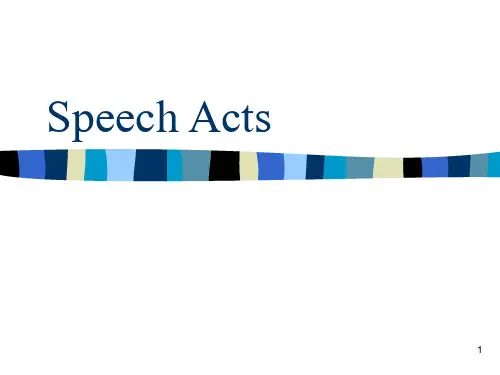

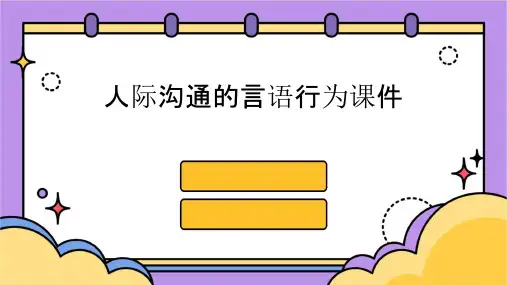
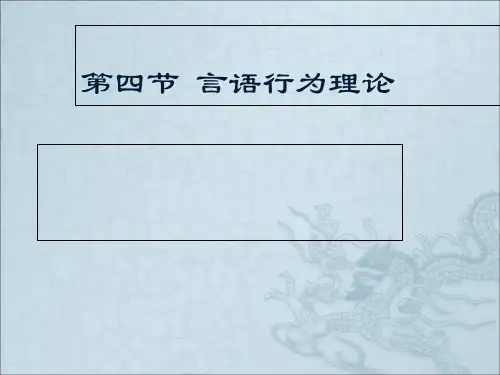

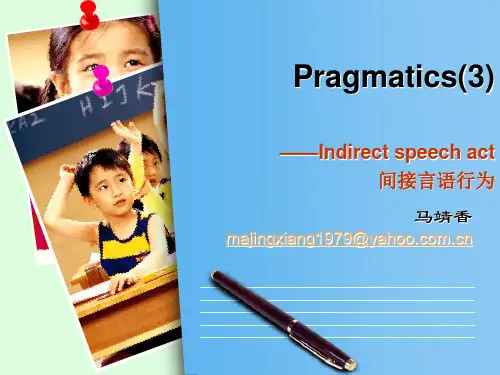
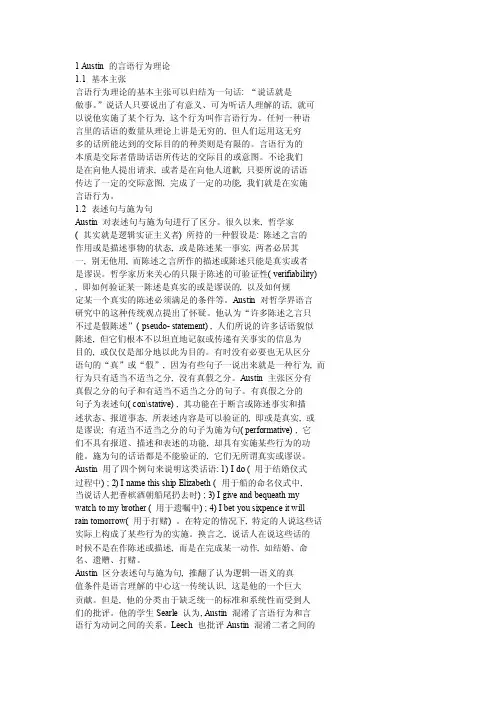
1 Austin 的言语行为理论1.1 基本主张言语行为理论的基本主张可以归结为一句话: “说话就是做事。
”说话人只要说出了有意义、可为听话人理解的话, 就可以说他实施了某个行为, 这个行为叫作言语行为。
任何一种语言里的话语的数量从理论上讲是无穷的, 但人们运用这无穷多的话所能达到的交际目的的种类则是有限的。
言语行为的本质是交际者借助话语所传达的交际目的或意图。
不论我们是在向他人提出请求, 或者是在向他人道歉, 只要所说的话语传达了一定的交际意图, 完成了一定的功能, 我们就是在实施言语行为。
1.2 表述句与施为句Austin 对表述句与施为句进行了区分。
很久以来, 哲学家( 其实就是逻辑实证主义者) 所持的一种假设是: 陈述之言的作用或是描述事物的状态, 或是陈述某一事实, 两者必居其一, 别无他用, 而陈述之言所作的描述或陈述只能是真实或者是谬误。
哲学家历来关心的只限于陈述的可验证性( verifiability) , 即如何验证某一陈述是真实的或是谬误的, 以及如何规定某一个真实的陈述必须满足的条件等。
Austin 对哲学界语言研究中的这种传统观点提出了怀疑。
他认为“许多陈述之言只不过是假陈述”( pseudo- statement) , 人们所说的许多话语貌似陈述, 但它们根本不以坦直地记叙或传递有关事实的信息为目的, 或仅仅是部分地以此为目的。
有时没有必要也无从区分语句的“真”或“假”, 因为有些句子一说出来就是一种行为, 而行为只有适当不适当之分, 没有真假之分。
Austin 主张区分有真假之分的句子和有适当不适当之分的句子。
有真假之分的句子为表述句( con\stative) , 其功能在于断言或陈述事实和描述状态、报道事态, 所表述内容是可以验证的, 即或是真实, 或是谬误; 有适当不适当之分的句子为施为句( performative) , 它们不具有报道、描述和表述的功能, 却具有实施某些行为的功能。
